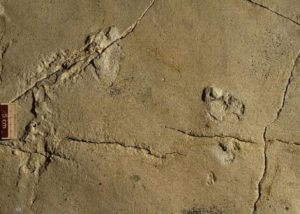
5,7 million-year old traces question the theory of human evolution
 23. 02. 2018
23. 02. 2018

"The controversy over this discovery is the age and location of the tracks," said one researcher. Newly discovered traces in Crete can nicely confuse experienced experts with an established story about early human development. The estimated age of the mysterious footprints is about 5,7 million years, and they originated at a time when previous major research had placed our ancestors with monkey feet on the African continent - and not on an island in the Mediterranean. This discovery could change everything.
Since the discovery of the Australopithek fossil in South and East Africa some 60 years ago, human origin has been firmly placed on the African continent. However, a new finding in Greece - specifically on the small island of Trachilos near Crete - could call into question the history of evolution as we know it. This is mainly because renowned researchers argue that the early members of the human lineage not only came from Africa, but remained isolated on this continent for millions of years before finally dispersing into Europe and Asia.
The research, published in Proceedings of the Geologists' Association, by an international team of experts, reveals the discovery of human footprints in the Cretan archipelago, which are believed to have approximately 5,7 million years. This date is controversial for many reasons. First, the age itself is a mystery when, according to the main theories before 5,7, millions of years lived our ancestors in Africa. The mainstream of scientists also claimed that at that time our ancestors had legs developed more like a monkey than similar to modern humans.
 Experts are surprised - and should be. Unlike all other terrestrial animals, human feet are very distinctive in shape: they combine a long leg with five forward-pointing fingers without claws, and a distinctive thumb is a distinctive thumb. The legs of our closest relatives are more like a human hand with a protruding thumb. Experts say the so-called Laetoli, which they think belongs to Australopithek, is very similar to the footsteps of modern humans, with the difference that the heels are narrower and the feet do not have the right vault.
Experts are surprised - and should be. Unlike all other terrestrial animals, human feet are very distinctive in shape: they combine a long leg with five forward-pointing fingers without claws, and a distinctive thumb is a distinctive thumb. The legs of our closest relatives are more like a human hand with a protruding thumb. Experts say the so-called Laetoli, which they think belongs to Australopithek, is very similar to the footsteps of modern humans, with the difference that the heels are narrower and the feet do not have the right vault.
Ardipithecus ramidus - a species of Hominina (Hominidé subfamily) classified as Australopithecine of the genus Ardipithecus - from Ethiopia with an approximate 4,4 age of millions, is the oldest known hominin with quite complete fossils but has a monkey foot. Scientists who have described this specimen claim to be a direct ancestor of later hominids, suggesting that at that time the human foot has not yet developed.
And now in Trachilos, Western Crete, you have the 5,7 trail of a million years old and have an unmistakable human shape: the thumb is similar to our shape, size, and position; and the foot is relatively shorter but has the same general shape. It clearly indicates that he is one of the early hominids - someone who should be more primitive than the one who left traces in Laetoli.
"What makes this discovery debatable is the incredible age and location of the tracks, ”Says Professor Per Ahlberg of Uppsala University, the last author of the study. “This discovery challenges the established story of early human evolution, and will likely raise a lot of debate. Whether research communities in the field of human origin will accept fossil footprints as conclusive evidence of the presence of hominins in Miocene, Crete, will be seen, ”Ahlberg added.





 1
1